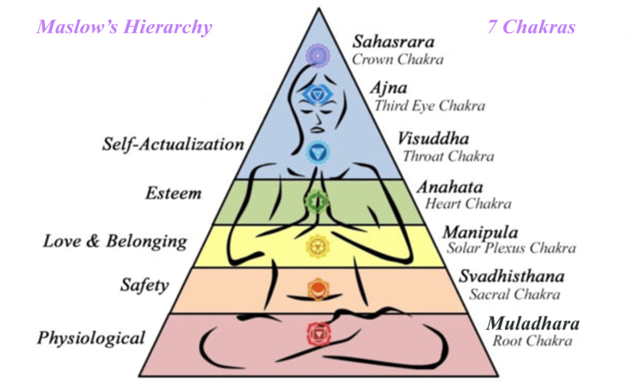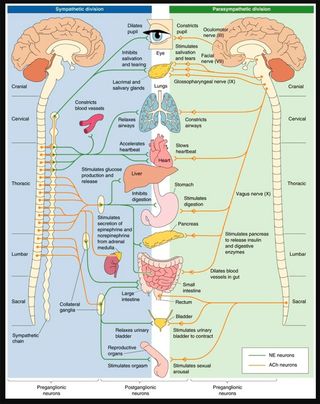Psychology
Maslow's Hierarchy vs. the 7 Chakras: Interestingly Similar
Could blending Eastern philosophy and Western psychology be the key to success?
Posted April 15, 2018 Reviewed by Ekua Hagan
I am a true believer in integrating Eastern and Western treatments/methods for optimal well-being, which is why I was so surprised I never noticed the similarities between Maslow’s Hierarchy of Needs and the 7 Chakras.
Recently, I was working with one of my patients who has severe attachment disturbance. In this session, I was trying to convey basic safety needs, and after realizing that a picture says a thousand words, opened one of my psychology books to the Maslow Hierarchy, also called the Maslow Hierarchy of Needs, which was written in 1943.
As I was going over this chart and what it means, suddenly, something hit me. The various Maslow Hierarchy levels were almost identical to the 7 Chakras used in these areas.
Interestingly, most European and American scholars in psychology and the general populace in 1943 had never heard of the word Chakra, let alone understood its meaning. My first reaction was that I discovered something because, in all of my training and education, this was never brought up. I thought I discovered that Abraham Maslow took his idea of the hierarchy from the concepts of the different Chakras.
I decided to search the web to see if others, similar to myself, had also discovered this. What I found was that I was definitely not the first; in fact, there are over 76,000 results comparing Maslow’s Hierarchy to the Chakras. This was a great surprise to me since until that moment in the session mentioned above, I never made the connection between the two. And what I’ve discovered was that most people in psychology and mental health haven’t either, since they were never trained in Chakra.
Let’s take a closer look at the meaning behind Maslow’s Hierarchy and the 7 Chakras.

The Root Chakra
The Root Chakra is the first chakra and is located at the base of the spine. It is the “root” of your being and establishes the deepest connections with your physical being, your environment, and with the Earth. It is responsible for your sense of safety and security. If you don’t feel safe, you can’t ever feel a sense of trust, which is part of the Heart Chakra. This is extremely important in basic attachment and security. Without this, many physical and emotional issues can arise.
You see, if you are not feeling safe, this activates your autonomic nervous system, which is the part of the nervous system responsible for the control of the bodily functions not consciously directed, such as breathing, the heartbeat, and digestive processes. It is your fight or flight, which includes your immune system.

Take a look at the photo to the left.
This is one of the main areas that causes PTSD when under the effects of trauma or lack of safety. So while food and shelter provide basic needs, to truly feel inner peace you need to feel safe. Only when you feel safe can you allow yourself to feel loved and feel a sense of belonging.
The Solar Plexus Chakra
The third chakra is located in your abdomen, above your belly button. It is the energy center responsible for personal power, self-esteem and confidence, and control over yourself and others. To allow this is a sense of personal power, and achieving control over yourself can be very empowering.
The Heart Chakra
The Fourth Chakra is the Heart Chakra. It is the core of your deep bonds with other people, your sense of caring and compassion, your feelings of self-love, generosity, kindness, and respect. When you open your heart, you can receive love, compassion, and are more flexible and open to change. Maslow refers to this level as the “Love & Belonging Needs." Without relationships and human interactions, a person can feel isolated, depressed, or lonely, while an abundance of love, community, and social interaction can sustain people through difficult times.
The Throat Chakra
This chakra supports self-expression, communication, and truth, allowing us to express ourselves completely. When you feel safe, loved, and have a sense of self, you can freely speak and communicate your feelings. Maslow refers to this area as Esteem Needs. Esteem needs refer to the need for self-esteem, self-confidence, and mastery of oneself. As Maslow explains, these needs are the basis for the human desire we all have to be accepted and valued by others.
The Brow Chakra
The Brow Chakra, also referred to as the third eye, is where our consciousness is located. It is the center of intuition, foresight, and perception and directs our sight and everyday awareness of the world. When you achieve this level, you have compassion, attunement with yourself and others, an inner awareness, and a feeling of service.
The Crown Chakra
The seventh and final chakra is called the Crown Chakra. The crown chakra is located at the top of the head. It leads to higher states of consciousness. It is the center of trust, devotion, inspiration, harmony, compassion, and the sense of oneness.
Maslow combines the final two chakras into his last level, the need for self-actualization. It is the highest level of Maslow’s hierarchy of needs. Achieving personal growth and development throughout your life allows for self-mastery, the desire to help others, and a sense of the meaning of life. Once you are self-actualized, you’ve met your full potential as an individual.
How Does Maslow’s Hierarchy Fit Into Chakra?
The similarity between the two systems is very obvious. We will never know if Maslow knew about Chakra and translated it into a Western style, or whether the universe somehow presented to both cultures this guide to self-development and actualization. I personally feel very blessed that I was trained in both, and work daily to clear my Chakras and fulfill the various levels of both the 7 Chakras and the Maslow Hierarchy of Needs. I hope you found this as enlightening as I did.
Could blending Eastern philosophy and Western Psychology be the key to reaching your full potential? What do you think?
Copyright © Diane Roberts Stoler, Ed.D. April 2018




